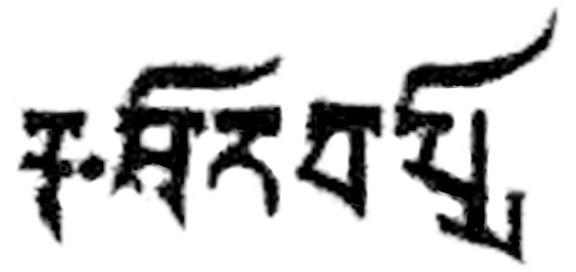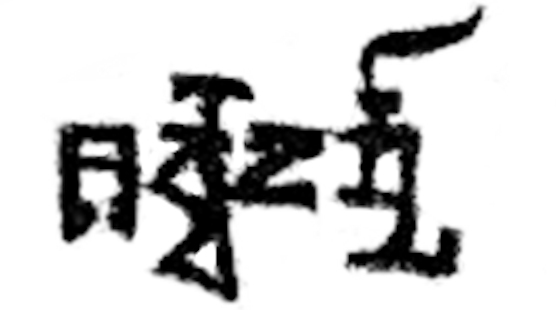|
Ishanavarman
Iśanavarman ( Gupta script: , ''Ī-śā-na-va-rmmā'') was the first independent Maukhari ruler of Kannauj. He was a very powerful king, and adopted the title of ''Maharajadhiraja''. Early life Ishanavarman was the son of the powerful Maukhari ruler Ishvara-varman (Iśvaravarman) and his queen Devi Upagupta. He was well known for his skill as an archer, particularly against enemy cavalry and elephants. Ishanavarman ascended the throne in 550 CE or 554 CE, probably after his father's death. Reign The early Maukhari rulers had been on very friendly terms with the Later Guptas, and even conducted marriage alliances between themselves. An example is Ishanavarman's own mother Devi Upagupta, who was married to Ishvara-varman. However, things changed with time under him. Under Ishanavarman, the Maukharis began to assert their independence from the Later Guptas. Ishanavarman became hostile to the former overlords of the Maukharis, in order to conquer Magadha. Ishanavarman revived ... [...More Info...] [...Related Items...] OR: [Wikipedia] [Google] [Baidu] |
Ishanavarman In The Asirgarh Inscription
Iśanavarman ( Gupta script: , ''Ī-śā-na-va-rmmā'') was the first independent Maukhari ruler of Kannauj. He was a very powerful king, and adopted the title of ''Maharajadhiraja''. Early life Ishanavarman was the son of the powerful Maukhari ruler Ishvara-varman (Iśvaravarman) and his queen Devi Upagupta. He was well known for his skill as an archer, particularly against enemy cavalry and elephants. Ishanavarman ascended the throne in 550 CE or 554 CE, probably after his father's death. Reign The early Maukhari rulers had been on very friendly terms with the Later Guptas, and even conducted marriage alliances between themselves. An example is Ishanavarman's own mother Devi Upagupta, who was married to Ishvara-varman. However, things changed with time under him. Under Ishanavarman, the Maukharis began to assert their independence from the Later Guptas. Ishanavarman became hostile to the former overlords of the Maukharis, in order to conquer Magadha. Ishanavarman revived ... [...More Info...] [...Related Items...] OR: [Wikipedia] [Google] [Baidu] |
Maukhari
The Maukhari dynasty (Gupta script: , ''Mau-kha-ri'') was a post-Gupta dynasty who controlled the vast plains of Ganga-Yamuna for over six generations from their capital at Kannauj. They earlier served as vassals of the Guptas and later of Harsha's Vardhana dynasty. The Maukharis established their independence during the mid 6th century. The dynasty ruled over much of Uttar Pradesh and Magadha. Around 606 CE, a large area of their empire was reconquered by the Later Guptas. According to Hieun-Tsang, the territory may have been lost to King Shashanka of the Gauda Kingdom, who declared independence circa 600 AD. Religion The Maukharis were staunch Hindus. They tried to enforce and maintain the traditional social order among the people. Hinduism received state support, but Buddhism also managed to remain as a prominent religion. Army The Maukhari army consisted of elephants, cavalry and infantry. Ishanavarman in all probability would have taken much pains to reorganize the army an ... [...More Info...] [...Related Items...] OR: [Wikipedia] [Google] [Baidu] |
Maukhari Dynasty
The Maukhari dynasty (Gupta script: , ''Mau-kha-ri'') was a post-Gupta dynasty who controlled the vast plains of Ganga-Yamuna for over six generations from their capital at Kannauj. They earlier served as vassals of the Guptas and later of Harsha's Vardhana dynasty. The Maukharis established their independence during the mid 6th century. The dynasty ruled over much of Uttar Pradesh and Magadha. Around 606 CE, a large area of their empire was reconquered by the Later Guptas. According to Hieun-Tsang, the territory may have been lost to King Shashanka of the Gauda Kingdom, who declared independence circa 600 AD. Religion The Maukharis were staunch Hindus. They tried to enforce and maintain the traditional social order among the people. Hinduism received state support, but Buddhism also managed to remain as a prominent religion. Army The Maukhari army consisted of elephants, cavalry and infantry. Ishanavarman in all probability would have taken much pains to reorganize the army an ... [...More Info...] [...Related Items...] OR: [Wikipedia] [Google] [Baidu] |
Sharvavarman
Sharvavarman (Brahmi script: 𑀰𑀭𑁆𑀯𑁆𑀯𑀯𑀭𑁆𑀫𑁆𑀫𑀸 , Gupta script: ''Śa-rvva-va-rmmā'', complete form: ''Śarvavarman Indra Bhattarika'') was a ruler of the Maukhari dynasty of Kannauj. He ruled circa 560-575 CE and had the title of " Mahārājādhirāja", "King of Kings" i.e. "Emperor". Shavavarman may have been the greatest of the Maukhari emperors, invading Magadha circa 575 CE and defeating the Later Guptas kings Damodaragupta and Mahasenagupta, which made him ruler of the entire Uttar Pradesh. Asirgarh and Nalanda seals Shavavarman was the son of Ishanavarman. He and the chronology of his family are rather well known, because of a copper seal he created: the Asirgarh seal. The seal reads: Several other nearly identical seals of Sharvavarman were also discovered in Nalanda. The content of the seals is identical, but small variations indicate that they come from different molds. Reign Sharvarman was an important rival of the Late Gup ... [...More Info...] [...Related Items...] OR: [Wikipedia] [Google] [Baidu] |
Sharva-varman
Sharvavarman (Brahmi script: 𑀰𑀭𑁆𑀯𑁆𑀯𑀯𑀭𑁆𑀫𑁆𑀫𑀸 , Gupta script: ''Śa-rvva-va-rmmā'', complete form: ''Śarvavarman Indra Bhattarika'') was a ruler of the Maukhari dynasty of Kannauj. He ruled circa 560-575 CE and had the title of " Mahārājādhirāja", "King of Kings" i.e. "Emperor". Shavavarman may have been the greatest of the Maukhari emperors, invading Magadha circa 575 CE and defeating the Later Guptas kings Damodaragupta and Mahasenagupta, which made him ruler of the entire Uttar Pradesh. Asirgarh and Nalanda seals Shavavarman was the son of Ishanavarman. He and the chronology of his family are rather well known, because of a copper seal he created: the Asirgarh seal. The seal reads: Several other nearly identical seals of Sharvavarman were also discovered in Nalanda. The content of the seals is identical, but small variations indicate that they come from different molds. Reign Sharvarman was an important rival of the Late Guptas ... [...More Info...] [...Related Items...] OR: [Wikipedia] [Google] [Baidu] |
Later Guptas
The Later Gupta dynasty ruled the Magadha region in eastern India between the 6th and 8th centuries CE. The Later Guptas succeeded the imperial Guptas as the rulers of Magadha, but there is no evidence connecting the two dynasties; these appear to be two distinct families. The Later Guptas are so-called because the names of their rulers ended with the suffix "-gupta" ( Late Brahmi: ''gu-pta''), which they might have adopted to portray themselves as the successors of the imperial Guptas. History After the decline of the Gupta Empire, the Later Guptas succeeded them as the rulers of Magadha. The daughter of the dynasty's founder Krishnagupta is said to have married prince Adityavarman of the Maukhari dynasty. According to the Aphsad inscription of Ādityasena, Krishnagupta's grandson Jivitagupta carried out military expeditions in the Himalayan region and southwestern Bengal. During the reign of Jivitagupta's son Kumaragupta, the dynasty developed a rivalry with the Maukharis ... [...More Info...] [...Related Items...] OR: [Wikipedia] [Google] [Baidu] |
Chalukya Dynasty
The Chalukya dynasty () was a Classical Indian dynasty that ruled large parts of southern and central India between the 6th and the 12th centuries. During this period, they ruled as three related yet individual dynasties. The earliest dynasty, known as the "Badami Chalukyas", ruled from Vatapi (modern Badami) from the middle of the 6th century. The Badami Chalukyas began to assert their independence at the decline of the Kadamba kingdom of Banavasi and rapidly rose to prominence during the reign of Pulakeshin II. After the death of Pulakeshin II, the Eastern Chalukyas became an independent kingdom in the eastern Deccan. They ruled from Vengi until about the 11th century. In the western Deccan, the rise of the Rashtrakutas in the middle of the 8th century eclipsed the Chalukyas of Badami before being revived by their descendants, the Western Chalukyas, in the late 10th century. These Western Chalukyas ruled from Kalyani (modern Basavakalyan) until the end of t ... [...More Info...] [...Related Items...] OR: [Wikipedia] [Google] [Baidu] |
Madra
Madra (Sanskrit: ) was an ancient Indo-Aryan tribe of north-western South Asia whose existence is attested since the Vedic period. The members of the Madra tribe were called the Madrakas. Location The Madras were divided into -Madra ("northern Madra"), -Madra ("southern Madra"), and Madra proper: *The Uttara Madrakas lived to the north of the Himavat, near the Uttara Kurus, possibly in the Kashmir Valley. *The Madras proper lived in the Rachna Doab in the central Punjab, to the west of the Irāvatī river. These Madras were organised into a kingdom and had their capital at Sāgala or Śākala. *The Dakṣiṇa Madrakas lived to the east of Śākala, near the Trigartas. History The Madrakas, as well as the neighbouring Kekaya and Uśīnara tribes, were descended from the Ṛgvedic Anu tribe which lived near the Paruṣṇī river in the central Punjab region, in the same area where the Madrakas were later located. Madra proper Several Vedic scholars from the period w ... [...More Info...] [...Related Items...] OR: [Wikipedia] [Google] [Baidu] |
Kalinga (historical Region)
Kalinga (Sanskrit: ), is a historical region of India. It is generally defined as the eastern coastal region between the Mahanadi and the Godavari rivers, although its boundaries have fluctuated with the territory of its rulers. The core territory of Kalinga now encompasses a large part of Odisha and northeastern part of Andhra Pradesh. At its widest extent, the Kalinga region also included parts of present-day Chhattisgarh, extending up to Amarkantak in the west. The Kalingas have been mentioned as a major tribe in the legendary text ''Mahabharata''. In the 3rd century BCE, the region came under Mauryan control as a result of the Kalinga War. It was subsequently ruled by several regional dynasties whose rulers bore the title ''Kalingādhipati'' ("Lord of Kalinga"); these dynasties included Mahameghavahana, Vasishtha, Mathara, Pitrbhakta, Shailodbhava, Somavamshi, and Eastern Ganga. The medieval era rulers to rule over the Kalinga region were the Suryavamsa Gajapatis, ... [...More Info...] [...Related Items...] OR: [Wikipedia] [Google] [Baidu] |
Anga
Anga (Sanskrit: ) was an ancient Indo-Aryan tribe of eastern South Asia whose existence is attested during the Iron Age. The members of the Aṅga tribe were called the Āṅgeyas. Counted among the "sixteen great nations" in Buddhist texts like the Anguttara Nikaya, Aṅga also finds mention in the Jain Vyakhyaprajnapti's list of ancient janapadas. Location Aṅga proper was located between the Champā river to the west and the Rajmahal hills to the east. However, at times, its territories did extend to the sea in the south, or included Magadha in the west. The capital of Aṅga, named Campā, was located at the confluence of the Campā and Gaṅgā rivers, and corresponds to the modern-day villages of Campāpurī and Champanagar in the eastern part of the Indian state of Bihār. According to the s, Campā was also called Kāla-Campā, while Puranic texts claim its ancient name was Mālinī. The other important cities within the Aṅga kingdom included (Sanskrit ... [...More Info...] [...Related Items...] OR: [Wikipedia] [Google] [Baidu] |
Vanga Kingdom
Vanga was an ancient kingdom and geopolitical division within the Ganges delta in the Indian subcontinent. The kingdom is one of the namesakes of the Bengal region. It was located in southern Bengal, with the core region including present-day southern West Bengal (India) and southwestern Bangladesh. Vanga features prominently in the epics and tales of ancient India as well as in the history of Sri Lanka. Vanga was probably the center of the Gangaridai Empire mentioned by numerous Greco-Roman writers. The exact capital of ancient Vanga kingdom could not be identified. After the rule of Gupta empire, ancient Bengal was divided into two independent states. They were the Gauda Kingdom and Vanga kingdom and archaeologists think that Kotalipara in present-day Bangladesh was the capital of the independent Vanga kingdom. Indian and Greco-Roman writers referred to the region's war elephants. In Indian history, Vanga is notable for its strong navy. There are numerous references to Van ... [...More Info...] [...Related Items...] OR: [Wikipedia] [Google] [Baidu] |
Kirtivarman I
Kirttivarman I ( IAST: Kīrtti-varman; r. c. 566-592) was a ruler of the Chalukya dynasty of Vatapi (present-day Badami) in India. He ruled parts of present-day Karnataka, Goa, Maharashtra and Andhra Pradesh. Kirttivarman was the son of his predecessor Pulakeshin I, the first sovereign ruler of the dynasty. He expanded the Chalukya kingdom by defeating the Nalas, the Mauryas of Konkana, the Kadambas, the Alupas, and the Gangas of Talakad. Names and titles Some of the dynasty's inscriptions call him Kirtti-raja. The Godachi inscription calls him Katti-arasa, which is probably a Kannada language variant of his name. Besides the regal title ''Maharaja'', the dynasty's inscriptions accord him the Chalukya family epithets '' Shri-prithvi-vallabha'', ''Vallabha'', and ''Satyashraya''. The Mahakuta pillar inscription of his brother Mangalesha compares him to the legendary king Puru, calling him ''Puru-rana-parakrama'' ("valourous in war like Puru"). Early life Kirttivarma ... [...More Info...] [...Related Items...] OR: [Wikipedia] [Google] [Baidu] |


_in_the_Asirgarh_seal.jpg)




.png)
.jpg)